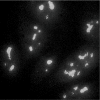Gold causes genetically determined autoimmune and immunostimulatory responses in mice
- PMID: 17680821
- PMCID: PMC2219286
- DOI: 10.1111/j.1365-2249.2007.03469.x
Gold causes genetically determined autoimmune and immunostimulatory responses in mice
Abstract
Natrium aurothiomaleate (GSTM) is a useful disease-modifying anti-rheumatic drug, but causes a variety of immune-mediated adverse effects in many patients. A murine model was used to study further the interaction of GSTM with the immune system, including induction of systemic autoimmunity. Mice were given weekly intramuscular injections of GSTM and controls equimolar amounts of sodium thiomaleate. The effects of gold on lymphocyte subpopulations were determined by flow cytometry. Humoral autoimmunity was measured by indirect immunofluorescence and immunoblotting, and deposition of immunoglobulin and C3 used to assess immunopathology. Gold, in the form of GSTM, stimulated the murine immune system causing strain-dependent lymphoproliferation and autoimmunity, including a major histocompatibility complex (MHC)-restricted autoantibody response against the nucleolar protein fibrillarin. GSTM did not cause glomerular or vessel wall IgG deposits. However, it did elicit a strong B cell-stimulating effect, including both T helper 1 (Th1)- and Th2-dependent isotypes. All these effects on the immune system were dependent on the MHC genotype, emphasizing the clinical observations of a strong genetic linkage for the major adverse immune reactions seen with GSTM treatment.
Figures



Similar articles
-
The genotype determines the B cell response in mercury-treated mice.Int Arch Allergy Immunol. 1998 Aug;116(4):295-305. doi: 10.1159/000023959. Int Arch Allergy Immunol. 1998. PMID: 9693280
-
Autoantibodies in outbred Swiss Webster mice following exposure to gold and mercury.Toxicol Appl Pharmacol. 2021 Feb 1;412:115379. doi: 10.1016/j.taap.2020.115379. Epub 2020 Dec 24. Toxicol Appl Pharmacol. 2021. PMID: 33358697
-
Evidence for immunostimulatory effects of intramuscular gold in patients with rheumatoid arthritis: correlation with skin reactions.J Rheumatol. 2003 Aug;30(8):1748-55. J Rheumatol. 2003. PMID: 12913930 Clinical Trial.
-
Murine silver-induced autoimmunity: silver shares induction of antinucleolar antibodies with mercury, but causes less activation of the immune system.Int Arch Allergy Immunol. 1997 Aug;113(4):432-43. doi: 10.1159/000237619. Int Arch Allergy Immunol. 1997. PMID: 9250589
-
Selective induction of anti-fibrillarin autoantibodies by silver nitrate in mice.Clin Exp Immunol. 1994 May;96(2):285-91. doi: 10.1111/j.1365-2249.1994.tb06555.x. Clin Exp Immunol. 1994. PMID: 8187336 Free PMC article.
Cited by
-
Gold Nanoparticles: Multifaceted Roles in the Management of Autoimmune Disorders.Biomolecules. 2021 Aug 30;11(9):1289. doi: 10.3390/biom11091289. Biomolecules. 2021. PMID: 34572503 Free PMC article. Review.
-
Animal models used to examine the role of the environment in the development of autoimmune disease: findings from an NIEHS Expert Panel Workshop.J Autoimmun. 2012 Dec;39(4):285-93. doi: 10.1016/j.jaut.2012.05.020. Epub 2012 Jun 27. J Autoimmun. 2012. PMID: 22748431 Free PMC article. Review.
-
Gold- and silver-induced murine autoimmunity--requirement for cytokines and CD28 in murine heavy metal-induced autoimmunity.Clin Exp Immunol. 2009 Mar;155(3):567-76. doi: 10.1111/j.1365-2249.2008.03831.x. Epub 2008 Dec 5. Clin Exp Immunol. 2009. PMID: 19077085 Free PMC article.
-
Exposure to Gold Induces Autoantibodies against Nuclear Antigens in A.TL Mice.Biology (Basel). 2024 Oct 11;13(10):812. doi: 10.3390/biology13100812. Biology (Basel). 2024. PMID: 39452121 Free PMC article.
-
Gold micro-particles for knee osteoarthritis.Eur J Pain. 2022 Apr;26(4):811-824. doi: 10.1002/ejp.1909. Epub 2022 Feb 1. Eur J Pain. 2022. PMID: 35076138 Free PMC article. Clinical Trial.
References
-
- Hultman P. Environmental factors in autoimmunity. In: Pollard KM, editor. Autoantibodies and autoimmunity: molecular mechanisms in health and disease. Berlin: Wiley-VCH; 2006. pp. 519–41.
-
- Rieger R, Leung PS, Jeddeloh MR, et al. Identification of 2-nonynoic acid, a cosmetic component, as a potential trigger of primary biliary cirrhosis. J Autoimmun. 2006;27:7–16. - PubMed
-
- Koller LD, Stang BV, Hall JA, Posada de la Paz M, Ruiz Mendez MV. Immunoglobulin and autoantibody responses in MRL/lpr mice treated with ‘toxic oils’. Toxicology. 2002;178:119–33. - PubMed
Publication types
MeSH terms
Substances
Grants and funding
LinkOut - more resources
Full Text Sources
Research Materials
Miscellaneous

